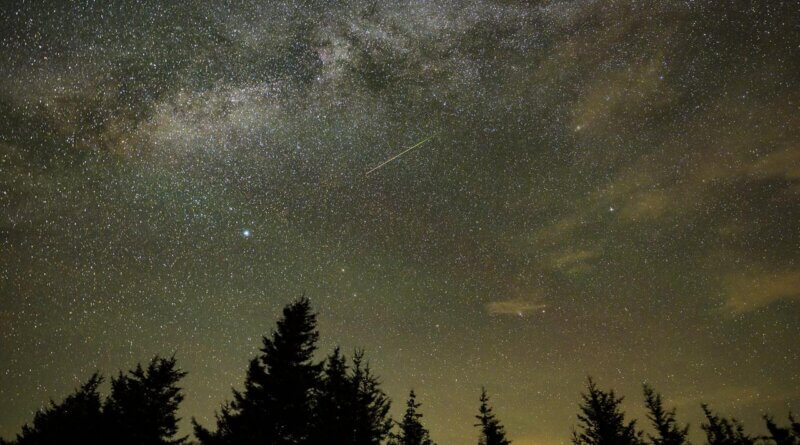Space Is The Place: The Night Sky Over Belper, August 2023
In August’s Night Sky Over Belper: Jupiter and Saturn return to the evening sky. The supermoon on the 31st is also a blue Moon. The Perseids meteor shower peaks on the 12 / 13th.
The Perseids Meteor Shower (17th July – 24th August)
The Perseids are the result of the trail of cosmic debris left behind by the Comet Swift-Tuttle. Every year the Earth passes through this cloud of debris. Fragments hit the Earth’s atmosphere and burn up as meteors. These meteors can be traced back to a radiant point in the sky, located in the constellation Perseus, and are therefore identifiable as Perseids.
Perseids are fast, bright meteors, some leave glowing trails (headline image, courtesy of NASA). This year the Perseids meteor shower peaks on the night of August 12 / 13th (Saturday evening into the early hours of Sunday). But it is worth looking for them in the nights leading up to the 12th and a couple of nights beyond (start from 11.00pm onwards). Note that light pollution (and clouds) will spoil your view – so moonless and clear nights are the best way to see Perseids, luckily there is only a waning Moon on the peak nights. To see the Perseids, you do not need to look in any particular direction, the best views are achieved by being able to see as much of the sky as possible.
Expect to see a meteor on average every 10 minutes or so. You will see less activity away from the peak nights, and it is also worth noting that meteors tend to appear in clusters followed by a lull, so, sometimes, patience is needed. See the link to Space Is The Place for notes on the 2022 Perseids meteor shower . This will give you an idea of what you are likely to see from a typical back garden in Belper.
Unfortunately, Meteor showers tend to be hyped-up by websites and media outlets (click bait to drive traffic to their sites). What you won’t see, unless astronomers have got it very wrong, is a meteor storm or meteors “lighting up the sky”. Meteor storms happen incredibly rarely, the most famous in living memory being caused by the Leonids over North America in 1966. Here is a report of the 1966 meteor storm as seen from the Mojave desert, by Christine Downing (extracted from the NASA website: Eye Witness Accounts of The 1966 Leonid Meteor Storm.)
Meteorites began to appear by 10:30 PM; there were about three or four every five minutes. At the time that seemed extraordinary, but by 12:30 it was raining stars over the entire sky. We were in a dark, desert valley bowl, rimmed by mountains; the Sierras were in the west. By 2:00 AM it was a “blizzard”. There was the unnerving feeling that the mountains were being set on fire. Falling stars filled the entire sky to the horizon, yet it was silent. If these Leonids had been hail, we wouldn’t have been able to hear each other. If they had been a show of fireworks, we would have been deaf.
The Moon
1st August: a full Moon (a supermoon).
17th of August: A crescent Moon.
31st of August: A full Moon (also a supermoon). This is the second full Moon in the month and is therefore designated as a blue Moon (as in “once in a blue Moon”). Do not expect the Moon to be blue – it won’t be).
31st of August: The full Moon appears to be close to Saturn.
The Planets
Saturn and Jupiter are now visible in the evening sky, both in the south east. Jupiter can be seen from 10.00pm onwards, low in the sky. Saturn is visible all night, shining in the south east.
A telescope will show Saturn’s rings and the main cloud bands of Jupiter and its Galilean moons (Io, Callisto, Europa and Ganymede)
The International Space Station`
The International Space Station is one of the brightest objects in the night sky. It is not hard to spot and flies-past periodically throughout the year. Fly-pasts tend to swing from PM to AM. Typically it will be in the sky for up to four minutes at a time. It moves slowly across the sky, at first bright and then fading as it moves over the horizon. NASA’s Spot the Station site tracks ISS and gives accurate forecasts of sightings. You may also want to sign up to the Alerts Site – which gives advance warning of the most prominent sightings. Note that the next series of evening passes will take place from mid-September up to early October.

